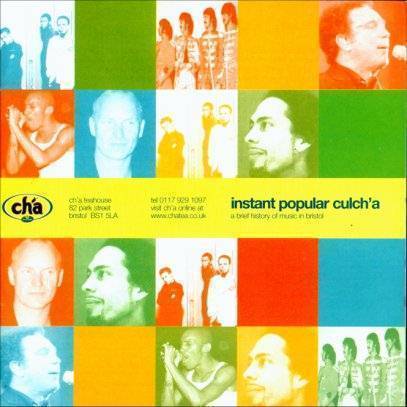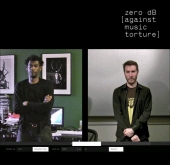
what is instant popular cluch'a?
The role of Bristol and Bristolians in the development of music, film and TV
has been enormously rich. The city and surrounding area are littered with cultural
memories and reference points. Some are well known, like the tragic death of
Eddie Cochran just hours after performing at the Bristol Hippodrome on Easter
Saturday 1960 and the city playing host to the filming of Truly, Madly, Deeply
in 1989/90. Others are more obscure, including playwright Tom Stoppard's six-year
stint on two local papers in the late 50s and the fact that Andrew Lloyd-Webber
wrote the lyrics for Don't Cry for Me Argentina in the city's Unicorn Hotel.
With this in mind and with an eye for detail that deems no moment of local cultural history too small or too trivial, Bristol's newest and brightest teahouse, ch'a, has commissioned two of the foremost chroniclers of British music, film and TV history to research and compile this first edition of' instant popular culch'a to celebrate the heritage of its new home. In their quest for a definitive snapshot of what really made Bristol tick in the 20th century, Dick Fiddy of the National Film Theatre and the Sunday Telegraph,' ancf Pete Frame, creator of the Rock Family Trees books and BBC TV series, have left no stone unturned.
But both Dick and Pete know that this first edition of the guide will not be definitive. As you read this brief history, available only from ch'a teahouse, and you spot any gaps you think need plugging, areas that might be expanded, or - horror of horrors - anything you believe might be a mistake, we'd love to hear from you. Please pass your comments to one of our members of staff at ch'a or visit our website at http://www.chatea.co.uk and e-mail us from there. Any suggestions included in future editions of the guide will be rewarded by being immortalised in print and their authors given free tea and toast.
We hope you enjoy our celebration of popular culture in this thriving city. From time to time we will bring Bristol's cultural heroes to life by honouring living legends or significant anniversaries in ch'a itself. Who knows? The next time you visit our teahouse, you may be drinking a draught to Gary Grant, Roni Size or Eddie Shoestring.
With thanks for additional
information to James Belsey
Nipper, the famous HMV dog and one of the music world's best-known and most-enduring
symbols and icons, was the theatre dog at the old Prince's Theatre in Park Row.
He belonged to the scenic artist, Mark Barraud. After Mark died, Nipper was
taken on by his brother Francis, who was so amused by Nipper's fascination with
the family phonograph that he painted the picture of His Master's Voice which
was subseauentiv immortalised the worid over.
Popular music in Bristol since the 50s
Bristol is
the birthplace of a great many musicians, including: pianist Russ Conway, 2.9.27:
Roger A Cook, 19.8.40 (Blue Mink, etc): Roger Greenaway, 23.8.42 (David and
Jonathan, etc): drummer/singer Robert Wyatt, 1945 (Soft Machine); drummer Timmie
Donald, 1946 (White Trash): singer James Warren, 25.8,51 (Stackridge, the Corgis);
singer Nik Kershaw, 1.3.58; guitarist Wayne Hussey, 26.5.59 (the Mission); journalist
Julie Burchill, 3.7.59; Sarah Dallen, 17.12.62, and Keren Woodward, 2.4.63 (they
met at school and later moved to London to form Bananarama).
Adam & the Ants
drummer Merrick went to Blackwell Comprehensive; Harriet Wheeler and David Gavurin
of the Sundays met at Bristol University; Hugh Cornwell of the' Stranglers studied
biochemistry at the University and supplemented his student grant by playing
acoustic background music in a Park Street Italian restaurant: and Bob Geldof's
sister was a teacher at Churchill School.
Bristol was home base for a bewildering array of idiosyncratic bands, like the
Cougars, Force West, Johnny Carr & the Cadillacs (all 60s), Magic Muscle,
Subway Sect, Glaxo Babies, Vice Squad, the Cortinas, Essential Bop,
the Pigs. Mystery Guests, the Numbers, Private Dicks (all 70s), the Pop Group,
Maximum Joy, Rip Rig And Panic, Pigbag, Electric Guitars, Mark Stewart &
the Mafia, Jo Boxers, the Chesterfields, the Blue Aeroplanes (all 80s).
The late 80s saw the
Seers, Brilliant Corners, Rhythm Party ("just like Bros only better looking"),
the Driscolls, the Helmets, Rorschach, the Loggerheads, Onslaught, Claytown
Troupe, Head, Smith & Mighty, the Flatmates, the Groove Farm and more. In
the early 90s came a plethora of bands, including the Moonflowers, Beatnik Filmstars,
Nautical William,
the Herb Garden, Me, Fruit, Strangelove, the Southernaires and Massive Attack
(who would become huge in no time at all with a Top Five album Protection/No
Protection in 94). Their collaborators, Nellee Hooper and Shara Nelson, would
also achieve national prominence independently.
In the mid-90s came
Portishead (see below), Telstarr, the Eff Word, Up Bustle and Out, Cool Breeze
(aka Charlie Laxton), 20 year-old Roni Size & Reprazent (who would take
the Mercury Music Award in 97), Tricky (aka Adrian Thaws - whose Maxinquaye
was a top three album in 95), the Heads, Hood, Send No Flowers, the Federation
(dance), Flynn 'n' Flora (drum 'n' bass), Movietone and Third Eye Foundation
(both lo-fi Flying Saucer Attack offshoots), More Rockers (ex Smith & Mighty),
97 charters Way Out West, the Experimental Pop Band (comprising ex- members
of Brilliant Corners), and 98's brightest hope Straw.
There is a long tradition of jazz in Bristol. The undisputed star venue for
live jazz in the city is the Old Duke in King Sir
many internationally-renowned jazz musicians have played there (check out the
posters that cover the walls and ceiling).
Every year, a two-day festival of jazz is held during late Summer outside the
Old Duke and between this pub and the Landoeger Trow opposite. The Trow is Bristol's
oldest pub. It once played host to Robert Louis Stevenson and it obviously,
left a profound effect on him as he based the Black Pig in Treasure Island on
the venue.
Local clubs/venues
have included Colston Hall in Colston Street (package shows/big deals), Electric
Village at the Locarno in Frogmore Street (a progressive era club, playing host
to the likes of Jimi Hendrix (Feb 67), the Granary at 32 Welsh Back (70s/80s),
the Dugout, the Berkeley Centre, Trinity Hall (new wave), the Anson Rooms at
the University (where Massive Attack came home to play four nights in Dec 98),
the Fleece & Firkin, the Louisiana, the Thekia, the Albert Inn, the Blue
Mountain Club. Lakota at 6 Upper York Street is a focal point for late 90s clubbers.
The first local group to make waves were the Kestrels, containing Roger Cook,
Roger Greenaway and Tony Burrows. Cook and Greenaway wrote a constant stream
of hits (like I'd Like To Teach The World To Sing) and together they hold the
joint record for the most appearances on a single edition of Top of the Pops
when they had a log-jam of hits under various Studio group names, including
White Plains, Pipkins, Sue and Sonny. Burrows was in many groups - like Edison
Lighthouse, and the Flowerpot Men - and, as THE session- singer of his generation,
he appeared on most of the early EIton John albums.
A few hours before his fatal
car crash, Eddie Cochran played his last gig at Bristol Hippodrome (Easter Saturday
16.4.60). The previous year, Lonnie Donegan had recorded his hit Battle of New
Orleans there. The same venue saw the start of the Wings tour in May 73 - the
first scheduled tour by an ex-Beatle since their last UK foray in 1966. In Sept
60 The Shadows played their first gig without Cliff - at Colston Hall. The same
venue presented everyone from the Beatles (four times) to Bob Dylan (May 66),
who returned there to shoot concert sequences for his unwatchable movie Hearts
of Fire, to local heroine PJ Harvey (Dec 98). Indeed the Beatles' first ever
national TV appearance was made at the TWW Studios in Brislington, Bristol.
Until that time, they had only ever appeared on regional TV in the North of
England.
In the early 60s,
American star Big Dee Erwin got lost on his way to Colston Hall, He stopped
outside the bowling alley in Kingswood to ask directions and gave a helpful
schoolboy half a crown and his autograph.
Jimmy Page played
at the Co-op Hall in Nov -63, as guitarist in Carter Lewis & the Southerners,
Tony Prince was resident DJ at the Top Rank before going off to become a star
at Radio Luxembourg, The Byrds played the Corn Exchange in Aug 65. Pink Floyd
played the Victoria Rooms in Sept 67.
In calmer moments,
Ronnie Lane wrote some of the lyrics to Itchycoo Park in a Bristol hotel room
after perusing a local tourism brochure which spoke of dreaming spires and a
bridge of sighs, and a few years later, Andrew Lloyd Webber wrote Don't Cry
For Me Argentina while staying at the Unicorn Hotel on the Dockside.
For a BBC television show
in 1970, Simon & Garfunkel played an unannounced concert at the Arnolfini
Theatre on Narrow Quay. Away from the glare of dubious publicity, Erasure played
their first ever gig at the tiny Western Star Domino Club, off Broadmead, in
Nov 85. It was while Paul McCartney was in Bristol visiting his girlfriend Jane
Asher (appearing at the Old Vie in early 66) that he was drawn to an old clothes
shop called Daisy Hawkins. The name inspired a new song, but by the time it
was recorded a few weeks later, it had metamorphosed into Eleanor Rigby
Mott the Hoople played one
of their earliest gigs (Nov 69) at t h e Granary; Marillion made a pre-signing
appearance there in Nov 82; Phil Lynott got up and played after a sold-out Thin
Lizzy gig at Colston Hall.
In 1987, Tracey Chapman made
her UK debut at the Bierkeller, third on the bill below Tanita Tikaram and John
Martyn. The Bunker Club (late 85 to mid 87) was run by Martin Whitehead of the
Flatmates who also operated the local Subway label from 3 Dove Lane.
After various names and guises,
the Locarno became the Studio in the late 80s. The Waterboys walked out of a
gig there after complaining that the audience had been packed in too tightly.
The sleeve for Echo &
the Bunnymen's second album Heaven Up Here was shot on the Severn estuary mudflats;
the sleeve of Bunnyman Will Sargeant's 1982 solo album Themes for Grind was
shot at the old Wills Tobacco warehouses near the Cumberland Basin, and on the
railway line near Ashton Gate.
Gary Clail (top ten with
Human Nature in 91) was said to have been a local scaffolder. In April 98, Cozy
Powell was declared dead on arrival at Frenchay Hospital. The 50 year- old drummer
had been driving down the M4 at 104 mph, en route to see his girlfriend in Cardiff,
when he lost control of his Saab 9000 Turbo. Told that he'd been drinking, he
was not wearing a seat belt and he was using a mobile phone at the time of the
accident, an inquest delivered a verdict of accidental death. Bristol has been
mentioned (if not immortalised) in several songs, including The Bn'stol Steam
Convention Blues by the Byrds, Bristol And Miami by Selecter and Bristol Express
by the (English) Eagles, which was featured in the Clive Donner film Some People
- set in sixties Bristol.
Bands behaving badly
- In Jan
64, the Rolling Stones (on tour with the Ronettes) were refused admission to
the Royal Hotel on College Green for sartorial irregularities.
- The Animals subsequently suffered the same fate.
- In 1960, the drunken hooligan Gene Vincent had been allowed to stay - as had
Eddie Cochran and Sharon Sheeley, who spent their last night together there.
- The Beatles played the Colston Hall on 10 Nov 64, the last night of their
final, full-length tour. A prankster climbed up into the building's roof and
dropped a flour bomb on the group. All four were covered in flour, and it took
Ringo Star several minutes to clear his drum kit.
- Ronnie Lane was physically hurled off the Colston Hall stage after abusing
the hall manager during a Small Faces concert with Canned Heat. Once he was
thrown into the audience, mayhem followed.
- Tom Jones refused to play Bristol for five years after a very early review
in the Evening Post wrote that he was "talentless" and should return
to South Wales, where he belonged. He eventually relented and went on to perform
in the city several times.
- The Move were banned from Bristol University's student union after Carl Way
temporarily appeared to take leave of his senses
with a felling axe. He first smashed a TV set and then set about the wooden
stage with his axe. The authorities were not amused.








